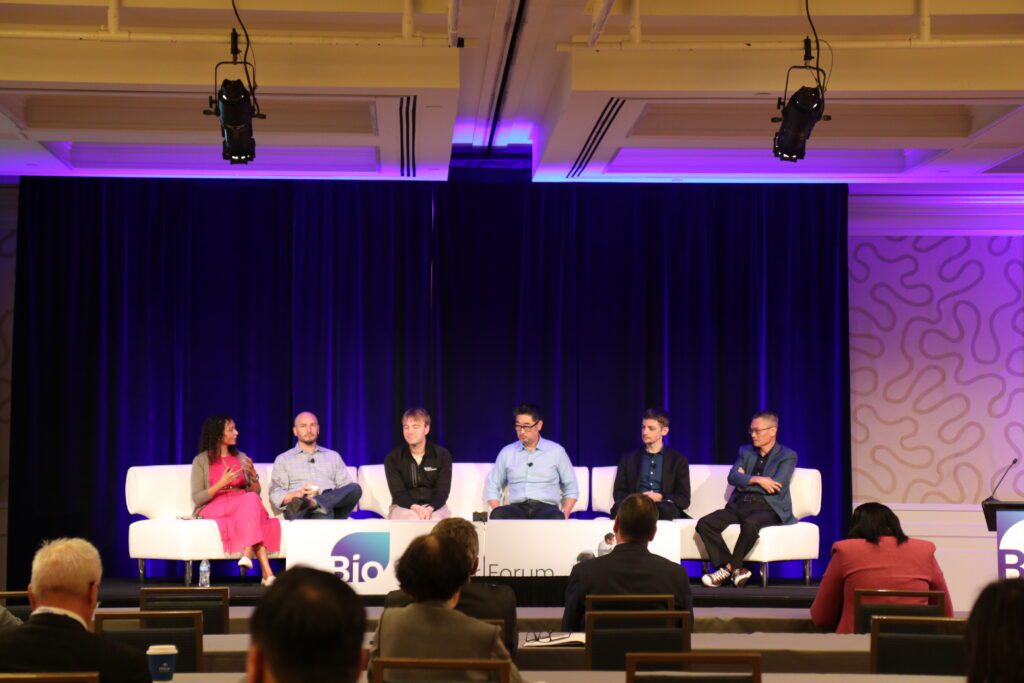Artificial Intelligence (AI) is saturating every aspect of human life—including life sciences. While the potential of AI and computational biology are vast, one of the most exciting aspects of the field is the ability to crack the code on undruggable targets.
“I feel like we’ve been talking about AI and computational bio for many years, but what has changed is that we’re starting to see some early proof points,” said Ruchita Sinha, General Partner at AV8 Ventures. She introduced the panel AI and Computational Biology to Reach Undruggable Targets at the 2023 Biotechnology Innovation Organization (BIO) Investor Forum.
“The first AI-design drug entered the clinic in 2020 and…we also know that the first AI-designed, AI-identified target happened a couple of years ago,” she said. “Additionally, Alpha Fold also recently came out with predictions for proteins of over 300,000 different proteins.”
“But the jury is still out as to whether or not AI has improved the probability of success of drugs in the clinic and I don’t think we’re far enough to get that data,” Sinha continued. “But I think that it has definitely helped us in identifying more powerful targets and designing more powerful molecules against them.”
How biotech companies are using AI and computational biology
The degree to which biotech companies are using AI and computational biology varies as well, with the spectrum ranging from AI-first to AI-second (or AI-supportive), etc.
“The future of biology is digital and [ThinkingNode Life Science, Inc] is using AI to clone biology,” said the company’s founder and CEO, Khai Minh Pham. “Once you have the digital model you can do a lot of things.”
“For us, AI and computational biology are fundamental. It’s not just an additional tool, it is the whole company is about the platform to generate this digital sample,” Pham continued.
“We sprinkle AI throughout our process,” added Mark DePristo, CEO and Co-Founder of BigHat Biosciences. “It’s really the combination of AI tech and custom targeted data generation that really unlocks problems in any antibody design and optimization space.”
“We’re probably an AI-second approach company and a biology first,” said Jerome Fox, CEO at Think Bioscience. “And so our focus is to basically say that biology is really good at coming up with bioactive molecules.”
AI brings questions, opportunities
AI brings up many answers, questions, and requisite developments. How do companies create libraries of information for AI? What degree of AI usage is most effective for any given area? What products and information can you present to partners in a way that is understandable? How do companies grow and create nuance in their work? These are just a few.
“There’s a very powerful platform approach regarding how you can leverage an end-to-end AI-built platform to better understand and better run experiments quickly, to gather data, and make your model smarter,” reflected Sinha. “On the flip side, you can also focus on very specific areas, such as RNA.”
“At Atomic AI, we’re not a purely computational company,” explains founder and CEO, Raphael Townshend “We have our own operating wet labs that are purpose-built to generate the right kind of data and to both train and validate the predictions of these models, and so we’re feeding in these very large-scale, purpose-built data sets in RNA. And RNA is very nice in some ways. You can collect very large-scale data sets around RNA, feeding it into these models, and then repurposing that model for all sorts of different prediction problems at once.”
“We are AI-first,” added Handol Kim, Co-Founder and CEO of Variational AI. “And the data problem and availability has been applicable to us.
“It’s very smart to generate data for AI because a lot of the data that’s available in the literature in the industry is awful. You can’t train a model based on it. it’s noisy, it’s full of false positives, it’s really, really bad. And of course, machine learning is built on data and the availability of it but also the quality.”
As the industry and knowledge grow, the data sets will improve. But it is that spectral aspect of the AI corner of the industry that helps build momentum and grow productivity in the future. When it comes to AI-supportive companies, Fox has an interesting perspective:
“Our favorite example is that a plant that is munched on by an insect can’t run away from that munching insect. So it makes a molecule that calls a predator of the insect over to the plant to destroy it. That’s unbelievable,” explained Fox. “The way we started with AI in mind was to basically recapitulate that process in the laboratory. We program a microbe with a drug design challenge and use that microbe to sample a unique chemical space to solve that challenge. In the beginning, there wasn’t AI unnecessarily in the solution, but we knew that we would need it to extract the types of solutions that we wanted.”
“The foundation model of a scientist is his or her reasoning model,” added Pham. “We do not use only data, we use data and knowledge. And for me, life science is not only data-driven; it is driven by processing data to generate knowledge. So, it’s much more knowledge-driven and it’s why you have scientists that have to take the output and make sense of it.”
“Historically, biotech companies haven’t had to think about what their data strategy was,” summarized Sinha. “Now, every company has to think about their data strategy and what they do with the data that they’re generating, as well as how they leverage it not only to make their platforms and applications more powerful but to help others, as well.”




